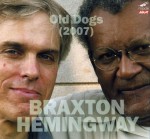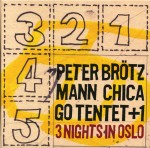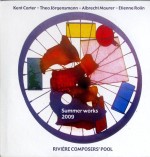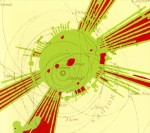Boxed sets of recorded music have long been a holiday gift favourite. But sophisticated music fans won’t settle for slapped together “best of” collections. However, well-organized boxes of improvised music which collect multiple CDs for specific reasons, should impress any aware music listener.
 Anthony Braxton/Gerry Hemingway’s Old Dogs (Mode Avant 9/12 www.moderecords.com) for instance is another instalment in the ongoing recorded history of multi-reedman Braxton. The four CDs feature him and percussionist Hemingway, an integral part of the reedist’s bands from 1983 to 1994, but who has rarely played with him since that time. Each 60-minute inventive Invention was recorded in real time without edits or alternate takes. Extrasensory cooperation is demonstrated as Braxton moves among seven saxophones and Hemingway a percussion collection. Should Braxton’s soprano saxophone obbligato turn staccato and superfast, Hemingway responds with centred vibraphone pings plus affiliated marimba pops. If subterranean contrabass saxophone tongue stops and watery glottal punctuation raucously sound, then abrasive ruffs on ride cymbals and drum rims produce nearly identical timbres. Hemingway’s percussion command is such that in a heartbeat he can produced a tone midway between that of a dumbeck and a set of tin cans to contrast with the reedist’s irregular tonguing; then as swiftly bring his entire kit into play using press rolls and ruffs to replicate foot-tapping swing that complements Braxton’s rare forays into masterful, story-telling runs on tenor saxophone.
Anthony Braxton/Gerry Hemingway’s Old Dogs (Mode Avant 9/12 www.moderecords.com) for instance is another instalment in the ongoing recorded history of multi-reedman Braxton. The four CDs feature him and percussionist Hemingway, an integral part of the reedist’s bands from 1983 to 1994, but who has rarely played with him since that time. Each 60-minute inventive Invention was recorded in real time without edits or alternate takes. Extrasensory cooperation is demonstrated as Braxton moves among seven saxophones and Hemingway a percussion collection. Should Braxton’s soprano saxophone obbligato turn staccato and superfast, Hemingway responds with centred vibraphone pings plus affiliated marimba pops. If subterranean contrabass saxophone tongue stops and watery glottal punctuation raucously sound, then abrasive ruffs on ride cymbals and drum rims produce nearly identical timbres. Hemingway’s percussion command is such that in a heartbeat he can produced a tone midway between that of a dumbeck and a set of tin cans to contrast with the reedist’s irregular tonguing; then as swiftly bring his entire kit into play using press rolls and ruffs to replicate foot-tapping swing that complements Braxton’s rare forays into masterful, story-telling runs on tenor saxophone.
 Another masterful saxophonist is German tenorist Peter Brötzmann. He never does anything by halves and Chicago Tentet +1’s 3 Nights in Oslo (Smalltown Superjazz STSJ197CD www.smalltownsuperjazz.com) consists of five CDs. No essay in self-aggrandizement, three of the discs feature band subsets. The two CDs featuring the ensemble are filled with the palpable excitement from 11 players collectively honking, fluttering and snorting. There’s space for all, with saxophonists Brötzmann and Mats Gustafsson creating reed gymnastics that encompass fortissimo runs, nephritic split tones and glottal punctuation. Contrapuntal brass layering melds Per Åke Holmlander’s elephantine tuba snorts, gut-bucket slurs from trombonists Jeb Bishop and Johannes Bauer, as drummers Paal Nilssen-Love’s and Michael Zerang’s flams and cymbal pressure chug underneath. Although it may seem that harmonies created by yapping horn blasts and polyrhythmic string friction from bassist Kent Kessler and cellist Fred Lonberg-Holm are opaque, the band has such control that the climax isn’t blood vessel bursting flashiness, but contrapuntal divisions exposing every texture. Two smaller groupings stand out. The tenor saxophone battle between Ken Vandermark and Joe McPhee allows undulating trills to bring needed balance to the duo’s initial ghostly shrieks and altissimo split tones. Elsewhere, Bishop, Bauer, Holmlander and McPhee on pocket trumpet, meld such extended techniques as metal buzzes, pedal-point burbles and peeping lip trills without losing chromatic mooring.
Another masterful saxophonist is German tenorist Peter Brötzmann. He never does anything by halves and Chicago Tentet +1’s 3 Nights in Oslo (Smalltown Superjazz STSJ197CD www.smalltownsuperjazz.com) consists of five CDs. No essay in self-aggrandizement, three of the discs feature band subsets. The two CDs featuring the ensemble are filled with the palpable excitement from 11 players collectively honking, fluttering and snorting. There’s space for all, with saxophonists Brötzmann and Mats Gustafsson creating reed gymnastics that encompass fortissimo runs, nephritic split tones and glottal punctuation. Contrapuntal brass layering melds Per Åke Holmlander’s elephantine tuba snorts, gut-bucket slurs from trombonists Jeb Bishop and Johannes Bauer, as drummers Paal Nilssen-Love’s and Michael Zerang’s flams and cymbal pressure chug underneath. Although it may seem that harmonies created by yapping horn blasts and polyrhythmic string friction from bassist Kent Kessler and cellist Fred Lonberg-Holm are opaque, the band has such control that the climax isn’t blood vessel bursting flashiness, but contrapuntal divisions exposing every texture. Two smaller groupings stand out. The tenor saxophone battle between Ken Vandermark and Joe McPhee allows undulating trills to bring needed balance to the duo’s initial ghostly shrieks and altissimo split tones. Elsewhere, Bishop, Bauer, Holmlander and McPhee on pocket trumpet, meld such extended techniques as metal buzzes, pedal-point burbles and peeping lip trills without losing chromatic mooring.
 Similarly the three CDs which make up Rivière Composers’ Pool - Summer Works 2009 (Emanem 5301 www.emanemdiscs.com) are divided among sessions by a quartet of Americans, bassist Kent Carter and woodwind player Etienne Rolin, and Germans, violist Albercht Maurer and clarinettist Theo Jörgensmann, plus trio and duo interaction. What’s instructive is how the musicians’ smaller meetings suggest ideas that eventually coalesce into the title suite. On the successive Music for a Ghost Story and Dance to This, Jörgensmann/Carter/Maurer build up wide-ranging modulations into a capriccio-like showcase including Jörgensmann’s flying glissandi, Carter’s string slaps and Maurer’s portamento runs. These movements are put to good use during the CD-length suite. From the exposition, where Rolin’s broken-octave basset horn extensions, chanter-like respiration from Jörgensmann’s clarinet, high-energy viola lines and sul tasto bass runs expand the theme, the variations cycle through quartet, trio, duo and solo episodes. If the clarinet outputs altissimo screeches, it’s calmed by Carter’s sul tasto stops; while speedy violin glissandi set the stage for mid-range reed licks. Putting aside bel canto or dissonant timbres, the climax downshifts to clarinet glissandi which push all into a gentling, diminuendo finale.
Similarly the three CDs which make up Rivière Composers’ Pool - Summer Works 2009 (Emanem 5301 www.emanemdiscs.com) are divided among sessions by a quartet of Americans, bassist Kent Carter and woodwind player Etienne Rolin, and Germans, violist Albercht Maurer and clarinettist Theo Jörgensmann, plus trio and duo interaction. What’s instructive is how the musicians’ smaller meetings suggest ideas that eventually coalesce into the title suite. On the successive Music for a Ghost Story and Dance to This, Jörgensmann/Carter/Maurer build up wide-ranging modulations into a capriccio-like showcase including Jörgensmann’s flying glissandi, Carter’s string slaps and Maurer’s portamento runs. These movements are put to good use during the CD-length suite. From the exposition, where Rolin’s broken-octave basset horn extensions, chanter-like respiration from Jörgensmann’s clarinet, high-energy viola lines and sul tasto bass runs expand the theme, the variations cycle through quartet, trio, duo and solo episodes. If the clarinet outputs altissimo screeches, it’s calmed by Carter’s sul tasto stops; while speedy violin glissandi set the stage for mid-range reed licks. Putting aside bel canto or dissonant timbres, the climax downshifts to clarinet glissandi which push all into a gentling, diminuendo finale.
 The wild card in this group is Sun Ra’s three-CD set of The Heliocentric Worlds (ESP-Disk 4062 www.espdisk.com). It confirms the composer/pianist’s legacy as an avant-garde Duke Ellington. Key players, such as saxophonists Marshall Allen and John Gilmore, plus Ra himself on pioneering electronic keyboards, solo impressively. Not only does the re-mastered 1965 set contain a recently discovered third disc, but each CD includes bonus material: a documentary film, a photo archive and contemporary writing. Like Ellington, Ra’s intricately shaded and organized arrangements create symphonic timbres with only 13 musicians. Phantasmagoric and polyphonic, extended tone poems like The Sun Myth are shaped by full-band expressions plus harmonies which contrast tuned bongos and sul ponticello bass thumps, or elsewhere contrapuntal saxophone vibrations and boogie-woogie piano runs. While The Cosmos takes its shape from call-and-response horn work, on other tunes Ra’s musical alchemy encompasses formalist piano tones, chalumeau bass clarinet smears and frenetic trumpet triplets.
The wild card in this group is Sun Ra’s three-CD set of The Heliocentric Worlds (ESP-Disk 4062 www.espdisk.com). It confirms the composer/pianist’s legacy as an avant-garde Duke Ellington. Key players, such as saxophonists Marshall Allen and John Gilmore, plus Ra himself on pioneering electronic keyboards, solo impressively. Not only does the re-mastered 1965 set contain a recently discovered third disc, but each CD includes bonus material: a documentary film, a photo archive and contemporary writing. Like Ellington, Ra’s intricately shaded and organized arrangements create symphonic timbres with only 13 musicians. Phantasmagoric and polyphonic, extended tone poems like The Sun Myth are shaped by full-band expressions plus harmonies which contrast tuned bongos and sul ponticello bass thumps, or elsewhere contrapuntal saxophone vibrations and boogie-woogie piano runs. While The Cosmos takes its shape from call-and-response horn work, on other tunes Ra’s musical alchemy encompasses formalist piano tones, chalumeau bass clarinet smears and frenetic trumpet triplets.
Each of these attractively packaged boxed sets demonstrates how expansive musical quality can be presented in an intelligent fashion. And each – or all – would make a fine addition to your CD collection.



